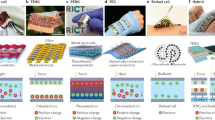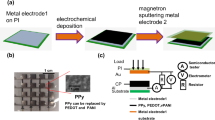Abstract
Flexible organic electronics can be used to create wearable devices but the synthesis of organic electronic materials typically involves hazardous solvents, creates toxic by-products and has various other environmental and economic costs. Being able to recycle organic electronic materials and devices in an eco-friendly and economical manner is thus key for their application in sustainable wearable electronics. Here we report organic flexible electronic devices with closed-loop recycling of each component. We develop approaches to recapture and reuse organic conductors, semiconductors and gate dielectrics, and evaluate the reliability of the recycled materials. Our fabrication and recycling processes also use only eco-friendly solvents (water, anisole and acetone). We illustrate the capabilities of the approach with various recyclable organic flexible electronic devices, including electrophysiological sensing electrodes, keypads, heaters/temperature sensors, electrochemical transistors and inverters. We also develop a sustainable device cycle by reconstructing various organic flexible electronics, which are fabricated using recycled materials from different functional devices without further replenishment.
This is a preview of subscription content, access via your institution
Access options
Access Nature and 54 other Nature Portfolio journals
Get Nature+, our best-value online-access subscription
$29.99 / 30 days
cancel any time
Subscribe to this journal
Receive 12 digital issues and online access to articles
$119.00 per year
only $9.92 per issue
Buy this article
- Purchase on Springer Link
- Instant access to full article PDF
Prices may be subject to local taxes which are calculated during checkout





Similar content being viewed by others
Data availability
The data that support the plots within this paper and other findings of this study are available from the corresponding author upon reasonable request.
References
Nelson, J. J. M. & Schelter, E. J. Sustainable inorganic chemistry: metal separations for recycling. Inorg. Chem. 58, 979–990 (2019).
Kwon, S.-J., Seo, H.-K., Ahn, S. & Lee, T.-W. Value-added recycling of inexpensive carbon sources to graphene and carbon nanotubes. Adv. Sustain. Syst. 3, 1800016 (2019).
Shi, C. Q. et al. Heterogeneous integration of rigid, soft, and liquid materials for self-healable, recyclable, and reconfigurable wearable electronics. Sci. Adv. 6, eabd0202 (2020).
Guo, Y. et al. Degradable and fully recyclable dynamic thermoset elastomer for 3D‐printed wearable electronics. Adv. Funct. Mater. 31, 2009799 (2020).
Guo, Y. et al. A dynamically hybrid crosslinked elastomer for room‐temperature recyclable flexible electronic devices. Adv. Funct. Mater. 31, 2106281 (2021).
Liu, H., Wang, L., Lin, G. & Feng, Y. Recent progress in the fabrication of flexible materials for wearable sensors. Biomater. Sci. 10, 614–632 (2022).
Liu, Y. X., Wang, H. Y. & Zhu, Y. Recycling of nanowire percolation network for sustainable soft electronics. Adv. Electron. Mater. 7, 2100588 (2021).
Yoo, B., Kim, Y., Han, C. J., Oh, M. S. & Kim, J. W. Recyclable patterning of silver nanowire percolated network for fabrication of flexible transparent electrode. Appl. Surf. Sci. 429, 151–157 (2018).
Teng, L. et al. Liquid metal-based transient circuits for flexible and recyclable electronics. Adv. Funct. Mater. 29, 1808739 (2019).
Williams, N. X., Bullard, G., Brooke, N., Therien, M. J. & Franklin, A. D. Printable and recyclable carbon electronics using crystalline nanocellulose dielectrics. Nat. Electron. 4, 261–268 (2021).
Li, Y. et al. Continuous preparation of chitosan-based self-powered sensing fibers recycled from wasted materials for smart home applications. Adv. Fiber Mater. 4, 1584–1594 (2022).
Sim, K. et al. Fully rubbery integrated electronics from high effective mobility intrinsically stretchable semiconductors. Sci. Adv. 5, eaav5749 (2019).
Chow, P. C. Y. & Someya, T. Organic photodetectors for next-generation wearable electronics. Adv. Mater. 32, 1902045 (2020).
Lee, Y. & Lee, T.-W. Organic synapses for neuromorphic electronics: from brain-inspired computing to sensorimotor nervetronics. Acc. Chem. Res. 52, 964–974 (2019).
Janasz, L., Borkowski, M., Blom, P. W. M., Marszalek, T. & Pisula, W. Organic semiconductor/insulator blends for elastic field-effect transistors and sensors. Adv. Funct. Mater. 32, 2105456 (2022).
Marrocchi, A., Facchetti, A., Lanari, D., Petrucci, C. & Vaccaro, L. Current methodologies for a sustainable approach to pi-conjugated organic semiconductors. Energy Environ. Sci. 9, 763–786 (2016).
Xing, L. W. & Luscombe, C. K. Advances in applying C-H functionalization and naturally sourced building blocks in organic semiconductor synthesis. J. Mater. Chem. C. 9, 16391–16409 (2021).
Bi, R. et al. Synthesis of sustainable production chains for phosgene-related byproducts. J. Clean. Prod. 374, 133979 (2022).
Li, C.-J. & Trost, B. M. Green chemistry for chemical synthesis. Proc. Natl Acad. Sci. USA 105, 13197–13202 (2008).
Bakhiya, N. & Appel, K. E. Toxicity and carcinogenicity of furan in human diet. Arch. Toxicol. 84, 563–578 (2010).
Jaladanki, C. K., Taxak, N., Varikoti, R. A. & Bharatam, P. V. Toxicity originating from thiophene containing drugs: exploring the mechanism using quantum chemical methods. Chem. Res. Toxicol. 28, 2364–2376 (2015).
Celebioglu, A., Topuz, F., Yildiz, Z. I. & Uyar, T. Efficient removal of polycyclic aromatic hydrocarbons and heavy metals from water by electrospun nanofibrous polycyclodextrin membranes. ACS Omega 4, 7850–7860 (2019).
Frontana-Uribe, B. A., Little, R. D., Ibanez, J. G., Palma, A. & Vasquez-Medrano, R. Organic electrosynthesis: a promising green methodology in organic chemistry. Green Chem. 12, 2099–2119 (2010).
Ngai, J. H. L. et al. Design and synthesis of stable indigo polymer semiconductors for organic field-effect transistors with high fluoride sensitivity and selectivity. RSC Adv. 9, 26230–26237 (2019).
Api, A. M. et al. RIFM fragrance ingredient safety assessment, anisole, CAS Registry Number 100-66-3. Food Chem. Toxicol. 159, 112680 (2022).
Prat, D. et al. CHEM21 selection guide of classical- and less classical-solvents. Green. Chem. 18, 288–296 (2016).
Nemani, S. K. et al. Surface modification of polymers: methods and applications. Adv. Mater. Interfaces 5, 1801247 (2018).
Kim, H.-J., Sim, K., Thukral, A. & Yu, C. J. Rubbery electronics and sensors from intrinsically stretchable elastomeric composites of semiconductors and conductors. Sci. Adv. 3, e1701114 (2017).
Oh, J. Y. et al. Self-seeded growth of poly(3-hexylthiophene) (P3HT) nanofibrils by a cycle of cooling and heating in solutions. Macromolecules 45, 7504–7513 (2012).
Lee, Y.-Y. et al. Growth mechanism of strain-dependent morphological change in PEDOT:PSS films. Sci. Rep. 6, 25332 (2016).
Chou, T.-R., Chen, S.-H., Chiang, Y.-T., Lin, Y.-T. & Chao, C.-Y. Highly conductive PEDOT:PSS film by post-treatment with dimethyl sulfoxide for ITO-free liquid crystal display. Mol. Cryst. Liq. Cryst. 612, 201–210 (2015).
Zhang, S. et al. Solvent-induced changes in PEDOT:PSS films for organic electrochemical transistors. APL Mater. 3, 014911 (2015).
DeLongchamp, D. M. et al. Influence of a water rinse on the structure and properties of poly(3,4-ethylene dioxythiophene):poly(styrene sulfonate) films. Langmuir 21, 11480–11483 (2005).
Zhang, X., Yang, W., Zhang, H., Xie, M. & Duan, X. PEDOT:PSS: from conductive polymers to sensors. Nanotechnol. Precis. Eng. 4, 045004 (2021).
Xiang, L. Y., Liu, L. Y., Zhang, F. J., Di, C. A. & Zhu, D. B. Ion-gating engineering of organic semiconductors toward multifunctional devices. Adv. Funct. Mater. 31, 2102149 (2021).
Thomas, E. M. et al. X‐ray scattering reveals ion‐induced microstructural changes during electrochemical gating of poly(3‐hexylthiophene). Adv. Funct. Mater. 28, 1803687 (2018).
Ye, Y.-S., Rick, J. & Hwang, B.-J. Ionic liquid polymer electrolytes. J. Mater. Chem. A 1, 2719–2743 (2013).
Trung, T. Q. et al. Freestanding, fiber-based, wearable temperature sensor with tunable thermal index for healthcare monitoring. Adv. Healthc. Mater. 7, 1800074 (2018).
Choi, S. et al. Stretchable heater using ligand-exchanged silver nanowire nanocomposite for wearable articular thermotherapy. ACS Nano 9, 6626–6633 (2015).
Wang, Y.-F. et al. Fully printed PEDOT:PSS-based temperature sensor with high humidity stability for wireless healthcare monitoring. Sci. Rep. 10, 2467 (2020).
Liu, H. et al. An ultrahigh linear sensitive temperature sensor based on PANI:graphene and PDMS hybrid with negative temperature compensation. ACS Nano 16, 21527–21535 (2022).
Zhang, L., Di, C. A., Yu, G. & Liu, Y. Q. Solution processed organic field-effect transistors and their application in printed logic circuits. J. Mater. Chem. 20, 7059–7073 (2010).
Friedlein, J. T., McLeod, R. R. & Rivnay, J. Device physics of organic electrochemical transistors. Org. Electron. 63, 398–414 (2018).
Yadav, Y., Ghosh, S. K. & Singh, S. P. High-performance organic field-effect transistors gated by imidazolium-based ionic liquids. ACS Appl. Electron. Mater. 3, 1496–1504 (2021).
Kim, Y.-H., Lee, E., Um, J. G., Mativenga, M. & Jang, J. Highly robust neutral plane oxide TFTs withstanding 0.25 mm bending radius for stretchable electronics. Sci. Rep. 6, 25734 (2016).
Roesing, M., Howell, J. & Boucher, D. Solubility characteristics of poly(3-hexylthiophene). J. Polym. Sci. B 55, 1075–1087 (2017).
Lee, K. H. et al. ‘Cut and stick’ rubbery ion gels as high capacitance gate dielectrics. Adv. Mater. 24, 4457–4462 (2012).
Lee, W. et al. Nonthrombogenic, stretchable, active multielectrode array for electroanatomical mapping. Sci. Adv. 4, eaau2426 (2018).
Bontapalle, S., Na, M., Park, H. & Sim, K. Fully soft organic electrochemical transistor enabling direct skin-mountable electrophysiological signal amplification. Chem. Commun. 58, 1298–1301 (2022).
Han, S. G., Polyravas, A. G., Wustoni, S., Inal, S. & Malliaras, G. G. Integration of organic electrochemical transistors with implantable probes. Adv. Mater. Technol. 6, 2100763 (2021).
Shahandashti, P. F., Pourkheyrollah, H., Jahanshahi, A. & Ghafoorifard, H. Highly conformable stretchable dry electrodes based on inexpensive flex substrate for long-term biopotential (EMG/ECG) monitoring. Sens. Actuator A 295, 678–686 (2019).
Zhang, L. et al. Fully organic compliant dry electrodes self-adhesive to skin for long-term motion-robust epidermal biopotential monitoring. Nat. Commun. 11, 4683 (2020).
Acknowledgements
This work was supported by the research funds (1.200090.01 and 1.230067.01) of the Ulsan National Institute of Science & Technology (UNIST) and the National Research Foundation of Korea (NRF) grant funded by the Korean Government (NRF-2021R1C1C1007714).
Author information
Authors and Affiliations
Contributions
H.P. and K.S. conceived the concept and designed the experiments. H.P., S.K., J.L. and I.L., prepared the materials and the fabricated devices. H.P. and J.L. characterized the device performance. H.P., S.K., I.L. and Y.N. performed the analysis of the materials. S.B. assisted H.P. to develop the materials. H.P., S.K., J.L. and K.S. analysed the experimental data. H.P. and K.S. wrote the paper. All authors reviewed and revised the paper.
Corresponding author
Ethics declarations
Competing interests
The authors declare no competing interests.
Peer review
Peer review information
Nature Electronics thanks Helen Tran and the other, anonymous, reviewer(s) for their contribution to the peer review of this work.
Additional information
Publisher’s note Springer Nature remains neutral with regard to jurisdictional claims in published maps and institutional affiliations.
Supplementary information
Supplementary Information
Supplementary Notes 1–6 and Figs. 1–44.
Rights and permissions
Springer Nature or its licensor (e.g. a society or other partner) holds exclusive rights to this article under a publishing agreement with the author(s) or other rightsholder(s); author self-archiving of the accepted manuscript version of this article is solely governed by the terms of such publishing agreement and applicable law.
About this article
Cite this article
Park, H., Kim, S., Lee, J. et al. Organic flexible electronics with closed-loop recycling for sustainable wearable technology. Nat Electron 7, 39–50 (2024). https://doi.org/10.1038/s41928-023-01078-9
Received:
Accepted:
Published:
Issue Date:
DOI: https://doi.org/10.1038/s41928-023-01078-9



